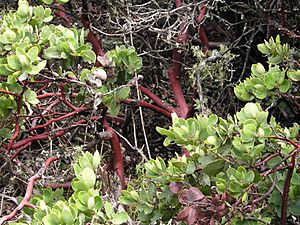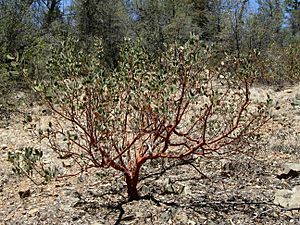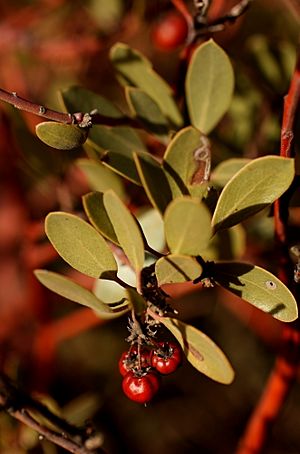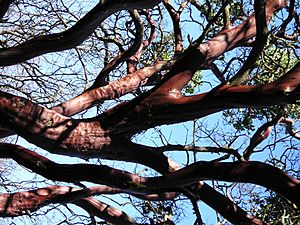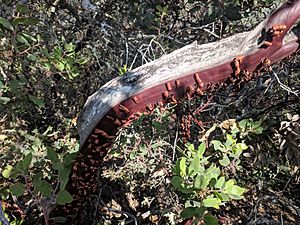Manzanita facts for kids
Manzanita is the name for many types of plants in the Arctostaphylos family. These are evergreen shrubs or small trees. You can find them in the chaparral areas of western North America. They grow from British Columbia and Washington down to Oregon, California, Utah, Arizona, New Mexico, and Texas. They also grow all over Mexico.
Manzanitas are tough plants. They can grow in places with bad soil and not much water. You can spot them by their smooth, orange or red bark. Their branches are often stiff and twisty. There are 105 different kinds of manzanita plants. Most of them (95 types) live in Mediterranean climate areas. They also grow in colder mountain regions of California.
These plants come in many sizes. Some hug the ground along the coast or in mountains. Others can grow into small trees, up to 20 feet (6 meters) tall. Manzanitas bloom in winter or early spring. They have berries in spring and summer. The berries and flowers from most types of manzanita are safe to eat.
The word manzanita comes from Spanish. It means "little apple". This name is sometimes used for plants in a related family called Arbutus. In Canada, Arbutus is also called manzanita. But in the United States, it's usually known as madrone.
Contents
What Are Manzanitas Used For?
Manzanita plants have many interesting uses. People have used them for medicine, food, and even decoration.
Traditional Medicinal Uses
Native Americans in Northern California used manzanita leaves. They made a special tea to help with poison oak rashes. The leaves have chemicals that can gently clean and fight germs. They can also help with mild bladder infections.
The berries can be made into a drink, like a cider. You mash the berries and add the same amount of water. Then you strain it. In Native American cultures, this cider helped with stomach problems. It also made people feel hungry. Berries were also used to help with bronchitis and kidney issues.
Manzanita leaves have other healing uses too. Chewing the leaves into a paste can treat open sores. Applying this paste can also help ease headaches. Just chewing the leaves, without swallowing them, can help with stomach cramps and aches. Drinks made from the leaves can also treat diarrhea and bad colds.
Manzanita as Food
Manzanita berries are a good food source. You can pick many of them and store them for later. Once dried, the berries can be ground into a coarse meal. You can eat the berries when they are ripe (red). Or you can eat them green for a slightly sour taste. They are tasty on their own. You can also use them to thicken or sweeten other dishes. Native Americans made cider from fresh berries. They even used the leaves as toothbrushes.
Manzanita in Gardens
Manzanitas are great ornamental plants for gardens. This is especially true in the western United States. They also do well in similar climates. They stay green all year. They don't need much water. Their bark is beautiful, and their flowers and berries are pretty. Plus, they come in many sizes and shapes.
For example, Arctostaphylos columbiana is very tough. It's used for landscaping along highways in Oregon and Washington. Low-growing manzanitas like Arctostaphylos 'Emerald Carpet'] and A. uva-ursi (the Bearberry) are excellent. They cover dry slopes and stay green. Bigger types, like Arctostaphylos 'Dr. Hurd,' can be grown alone. You can trim them to show off their cool branches. They like light, well-drained soil. But the low-growing types can handle heavier soils.
Manzanita for Decor
Manzanita branches are popular for decorating. People love their unique shape, color, and strength when dry. Florists use them as centerpieces at weddings and other events. They often add hanging candles, shiny beads, or small flowers to them.
The wood of manzanita is very hard to dry properly. It often cracks across the grain. This means it's not often used as lumber. It also grows slowly and has many branches. This makes it hard to get large, straight pieces. Some furniture and art use whole, round branches. This helps prevent cracking and keeps the deep red color.
Dead manzanita wood breaks down slowly. It can last for many years, even after falling off the plant. Sunlight makes manzanita wood smooth and white. It can look a bit like animal bones. Because of this, and the small, twisted shapes of many species, people collect unusual pieces. They sometimes call it mountain driftwood.
Manzanita wood is also used for perches for parrots and other large pet birds. The branches from bigger manzanita types last a very long time for this use. Some aquarium owners use sandblasted manzanita as driftwood in their fish tanks. It has a nice forked shape and doesn't change the water's chemistry.
If cleaned and dried correctly, it holds up well underwater for a long time. The wood also doesn't release much tannins into the water. This is a common problem with other types of aquarium driftwood. When used as driftwood, dry manzanita often floats. So, it needs to be weighted down or soaked for several weeks. Fresh, green wood does not float.
Dry manzanita wood burns very well. It's great for a campfire, barbecue, fireplace, or stove. It is dense and burns hot for a long time. But be careful! The high heat can damage thin barbecues. It can even crack cast iron stoves or cause chimney fires.
Other Cool Uses
During World War II, manzanita root burls were used. People made smoking pipes from them. This was because it was similar to briar wood, which was hard to get then. It was called "Mission Briar." People harvested it until the war ended. Then, imported briar became available again.
Rare Manzanita Plants
Some types of manzanita are among the rarest plants in the world.
Arctostaphylos hookeri ravenii, also called Presidio manzanita, is very rare. It is the most endangered plant in the mainland United States. In 1987, only one plant was left. It was in a secret spot in the Presidio of San Francisco National Historic Landmark District in San Francisco, California. Luckily, scientists have successfully made copies of this plant.
Arctostaphylos franciscana, or Franciscan Manzanita, is from San Francisco. It had not been seen growing wild since 1947. But in October 2009, it was found growing in the Presidio of San Francisco again! On January 23, 2010, Caltrans moved this plant. They moved it to make way for the Doyle Drive Replacement Project. Many groups helped pay for this move.
There's also an unknown type of Manzanita found on Parker Avenue in San Francisco. This plant is helping test San Francisco's Landmark Tree Ordinance.
Arctostaphylos gabrielensis is another "critically imperiled" type of manzanita. It only grows in one small area in the San Gabriel Mountains. This area is in Los Angeles County, California.
Images for kids


